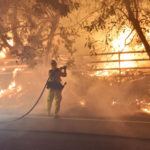Ben Brookes, RMS Vice President Capital Markets Solutions, posted the following blog update at 15:00 UTC , Friday August 25
Until yesterday evening Harvey looked like a rain-flooding threat, largely – likely to land-fall as a tropical storm or weak category 1 hurricane. With its potential to stall over the coastline, that scenario could have been dangerous, particularly for those local communities with significant flood risk.
The situation now looks more concerning: Harvey could become the first major hurricane to make landfall in the US since Wilma in 2005, some 12 years ago. This would add wind and storm surge threat to the rainfall-driven flood risk we were already worried about.
These are the moments we try our best to prepare for. The well-oiled RMS machinery moves into action as the Event Response and hurricane modeling teams keep a close eye on the forecasts, and we try to pull together the best possible insights for our clients.
Our first meeting to select possible storm tracks starts early. This is where we review the modeled storms selected by our scientists, to see which might be the best representations of how Harvey could play out.
At this stage, we’re looking at wind damage only.
There’s a buzz in the air – with a near miss last year, Hurricane Matthew reminded us what it felt like to go into full event response mode. Now we’re back together again, unusually early in the season for a possible major hurricane.
There is a sense of growing meteorological intrigue, coupled with the concern that lives and livelihoods are at risk thousands of miles away. I hope the local communities are prepared and are getting to safety. A lucky streak of no major hurricanes in over a decade also means the memory of the threat has probably faded in those areas. We hope not.
We discuss the exposure on the ground – it looks like Harvey is bearing down on areas of less dense exposure, and we note that unlike Matthew, a shift left or right from the current track won’t change that dramatically. But the big exception is Corpus Christi and the smaller towns along the coast which may be vulnerable to potential storm surge as well as wind. Our analysis also suggests industrial clusters in the region could face wind and flood damage.
We close the meeting hoping this is another dodged bullet for our industry. Our selection of scenarios suggests something in the low single-digit billions is most likely from wind damage. Low-attaching industry loss warranties could be at risk if the situation worsens dramatically, but that’s not the most likely outcome. What are the chances of that? Not high. Looking at the loss distributions based on this this morning’s event selection, using National Hurricane Center forecasts, we estimate there’s only a 10% chance that wind loss could exceed U.S. $6 billion. Although it probably won’t happen – it’s possible, clearly.
But look at the bigger picture. Our selection of possible Harvey wind scenarios contains much less damaging storm developments, including those with industry losses of less than $1 billion.
The RMS capital markets team have been busy looking into the potential impact on the cat bond market – at the moment we have our eyes on Fonden, with its parametric trigger extending from Mexico up the Texan coastline. If the central pressure of the storm drops significantly and it hits the box, that deal could be at risk. Likewise, we note a Res Re class with elevated attachment probability – albeit only slightly. Interestingly, at this point we don’t see the Alamo deals looking at risk. The relatively high attachment points might explain that. The situation will become clearer as the event unfolds, of course.
As the hurricane develops, our updates should give more insight on storm surge and inland flooding, which could be the dominant drivers.
Was this article valuable?
Here are more articles you may enjoy.


 State Farm Seeking Large Rate Increases in Wildfire-Prone California
State Farm Seeking Large Rate Increases in Wildfire-Prone California  As Rates Rise, Majority of Homeowners Say Insurance Industry Is in Crisis: Survey
As Rates Rise, Majority of Homeowners Say Insurance Industry Is in Crisis: Survey  US Home Insurance Still Priced Too Low for Climate Risk, Says Swiss Re Chair
US Home Insurance Still Priced Too Low for Climate Risk, Says Swiss Re Chair  Big ‘I’ Report: Independent Agency Channel Placed 62% of Premiums in 2023
Big ‘I’ Report: Independent Agency Channel Placed 62% of Premiums in 2023 

